|
|
Post by unclemasa on Feb 8, 2009 10:09:31 GMT -10
What I think is .....
As far as I can tell, the pictures, showing the other pitchers and features of the plant, leave me with only one questionable feature ...... coloration. This might be explained by environmental conditions or the plant's relatively young age. The angles match other examples of burbidgeae, the lid does not look like fusca, the marginate area fits, the peristome is flat and the leaves are not blunted like fusca.
I am not sure that it is "pure burbidgeae" but I think the evidence is insufficient to call it anything else. Although I, of course, understand what people mean when they talk about "pure" species, I find this terminology misleading. A 'species' defines a population and either a plant is a member of that set, by virtue of it being coincident with a range of definitional characteristics, or not. A variegated plant of a particular species is still a member of that species even if the colors don't match the description.
I am not closing the door on this classification but I would need further evidence to change the tag. Perhaps time and the further development of the plant will lead me to another conclusion.
|
|
Dave Evans
Nobiles
   dpevans_at_rci.rutgers.edu
dpevans_at_rci.rutgers.edu
Posts: 490
|
Post by Dave Evans on Feb 10, 2009 15:36:13 GMT -10
Sam, You really think it's the pure species? Wow, I guess Geoff was mistaken... You can lead a horse to water... Call that thing whatever you want, whatever makes you happy, man. Dear Michelle, I don't see any features in the plant which "push" it away from being N. burbidgeae. For example, what feature(s) would N. fusca have contributed? The pitchers of these two species are fairly distinct and I can't see any N. fusca influence. I do see the difference in the lid shape, but Sam's plant has better undulating margins. Probably, the best way to find out if this plant is a hybrid, would be for Sam to compare it to his other N. burbidgeae, which are hopefully not all from the same seed batch... |
|
|
|
Post by michelle on Feb 11, 2009 3:23:30 GMT -10
Sam, You really think it's the pure species? Wow, I guess Geoff was mistaken... You can lead a horse to water... Call that thing whatever you want, whatever makes you happy, man. Dear Michelle, I don't see any features in the plant which "push" it away from being N. burbidgeae. For example, what feature(s) would N. fusca have contributed? The pitchers of these two species are fairly distinct and I can't see any N. fusca influence. I do see the difference in the lid shape, but Sam's plant has better undulating margins. Probably, the best way to find out if this plant is a hybrid, would be for Sam to compare it to his other N. burbidgeae, which are hopefully not all from the same seed batch... Dear Dave, It does not matter to me if you agree or not. Just a question: Why do you think you know more than Exotica? What makes your observation better? Another question to ponder: How many times has Exotica pointed out the "truth" when confronted with a look-a-like almost pure species? I'm sure you aren't even aware of all the times they have corrected and pointed out misidentification. You have no idea what goes on behind the scenes. Exotica has shown time and time again that they have a great "eye". The same can't be said for ANYONE else in this discussion. The last questions: Why, o, why would Exotica say anything at all? Could it be because they see something that YOU and Sam do not see? ...Wouldn't be the first time. Remember, they could have kept their thoughts to themselves. Why not just be quiet? Making waves isn't always fun. When people lack respect for their opinion, I would imagine it would be very frustrating for them. Sam, Time for another poem? |
|
|
|
Post by unclemasa on Feb 11, 2009 12:24:55 GMT -10
michelle .....
Geoff and Andrea are among our most respected members. Their observations, experience, study and always reasoned arguments command the greatest respect from myself (... why do you think I would stay up late studying the descriptions), Dave and all the members of this forum. Please do not embarrass us all by suggesting otherwise.
To have reasoned disagreement over a diagnosis does not imply disrespect. To simply dismiss someone with a flippant "It does not matter to me if you agree or not." does.
You were simply asked about your reasoning. What observations or study you might have made that has lead you to the opinion you have. You mentioned the marginate area under the peristome and this has been addressed. Is there something else?
|
|
Dave Evans
Nobiles
   dpevans_at_rci.rutgers.edu
dpevans_at_rci.rutgers.edu
Posts: 490
|
Post by Dave Evans on Feb 11, 2009 16:38:43 GMT -10
Dear Dave, It does not matter to me if you agree or not. Just a question: Why do you think you know more than Exotica? What makes your observation better? Another question to ponder: How many times has Exotica pointed out the "truth" when confronted with a look-a-like almost pure species? I'm sure you aren't even aware of all the times they have corrected and pointed out misidentification. You have no idea what goes on behind the scenes. That's nice.  Anyway, if Sam's plant is a hybrid what makes you think the other parent is part N. fusca? I would think N. fusca would probably darken the coloration, instead this plant seems to have less color than the average N. b.. Maybe N. chaniana instead? |
|
|
|
Post by michelle on Feb 12, 2009 4:32:01 GMT -10
michelle ..... Geoff and Andrea are among our most respected members. Their observations, experience, study and always reasoned arguments command the greatest respect from myself (... why do you think I would stay up late studying the descriptions), Dave and all the members of this forum. Please do not embarrass us all by suggesting otherwise. To have reasoned disagreement over a diagnosis does not imply disrespect. To simply dismiss someone with a flippant "It does not matter to me if you agree or not." does. You were simply asked about your reasoning. What observations or study you might have made that has lead you to the opinion you have. You mentioned the marginate area under the peristome and this has been addressed. Is there something else? sam, The coloration, shape, lid, and peristome don't seem match true burbidgeae, in my opinion (whatever that's worth). You can't see the difference between your plant and others? Perhaps you are too close to see. If this were our plant in question, we would have humility and try to learn. The last time Exotica told us we were mistaken, we didn't disagree with them and deny it (like you), we accepted the information. We asked questions and then began to see the truth. There's a huge difference between Exotica's opinion and Dave Evans' opinion. If you want to pretend they're equal, that's your loss. If that is just plain old N. burbidgeae, Exotica wouldn't have said anything. For them to make a post, with photos, and reply, don't you think they must have noticed features you don't see? |
|
obregon562
Nobiles
   "I do believe Im feeling stronger everyday."
"I do believe Im feeling stronger everyday."
Posts: 387
|
Post by obregon562 on Feb 12, 2009 5:05:21 GMT -10
Michelle, What makes you so sure Exoticas word is the absolute truth? They are amazingly talented growers yes, but im sure they make a mistake once and a while. Shocking i know.  All your posts seem to leave a bad taste for Sam or Dave... Anyway, sams burb look "pure" (whatever that is!) to me. I do not believe the changes are large enough to warrant us not believing it is "pure". |
|
|
|
Post by michelle on Feb 12, 2009 8:03:32 GMT -10
Frankie,
I'm a BAAAD girl!
|
|
|
|
Post by unclemasa on Feb 12, 2009 9:57:17 GMT -10
michelle, As I said above, I am not closing the door on this diagnosis. I just feel that, at this time, my doubts are less than my confidences in calling this plant N. burbidgeae. Botanical descriptions are written to reflect the characteristics of the mature specimen and, as Geoff pointed out, this is not a mature specimen and we may have to wait a while before we know for sure it's true identity. I don't have a lot of N. burbidgeae in my collection and those that I do have are even less mature that the one in question. Still, doing what comparisons I can, I see no difference in growth pattern, leaf structure or attachment. In the original picture the lid does appear to be a bit more pointed and have wavier edges than one might expect. However, upon closer examination of this and the other pitchers currently on the plant this would appear to be a result of the way the pitcher ages rather than a difference in structure. Like with any pitcher the older and more dessicated the lid the more contracted and wavy it becomes.  On mature plants the upper pitchers seem very chesty and the original picture, prompting this discussion, portrays a plant that does look less chesty and is a bit more elongated by comparison. 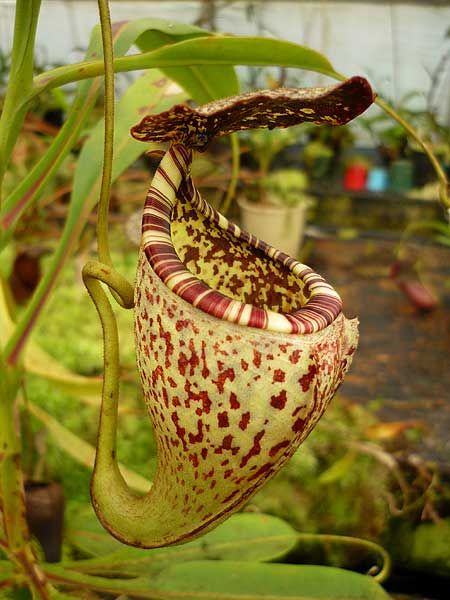 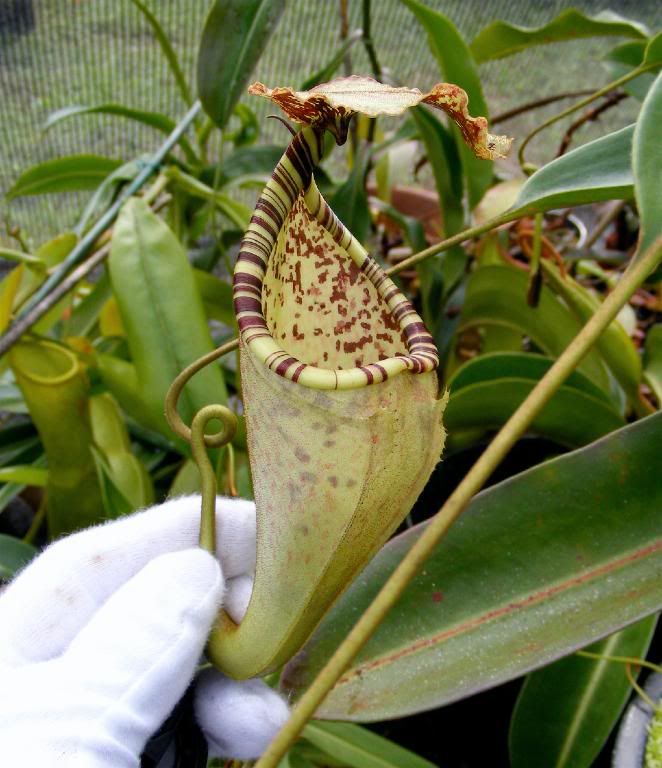 On the other hand, if we compare it to another pitcher from Geoff's plant then, the differences in shape and angle seem less significant. 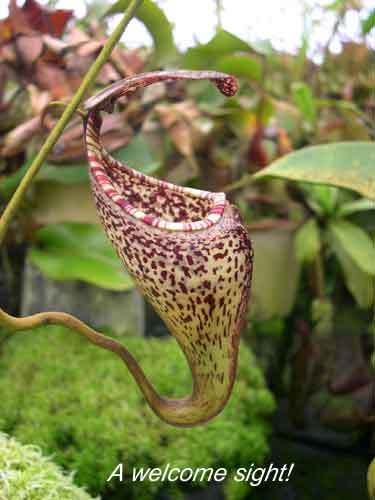 This also seems to be the case with the peristome. In the original picture the peristome looks a bit odd, rising more dramatically in the back and appearing less flattened at the upper surface when compared to the peristome on a more mature pitcher. On the other hand, when compared to another pitcher on the same plant the differences are few if any. 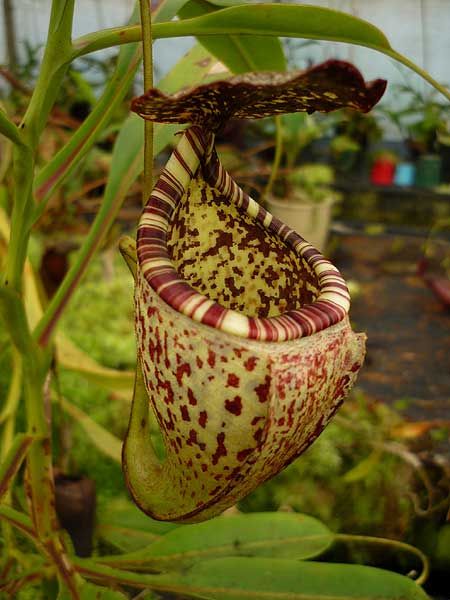 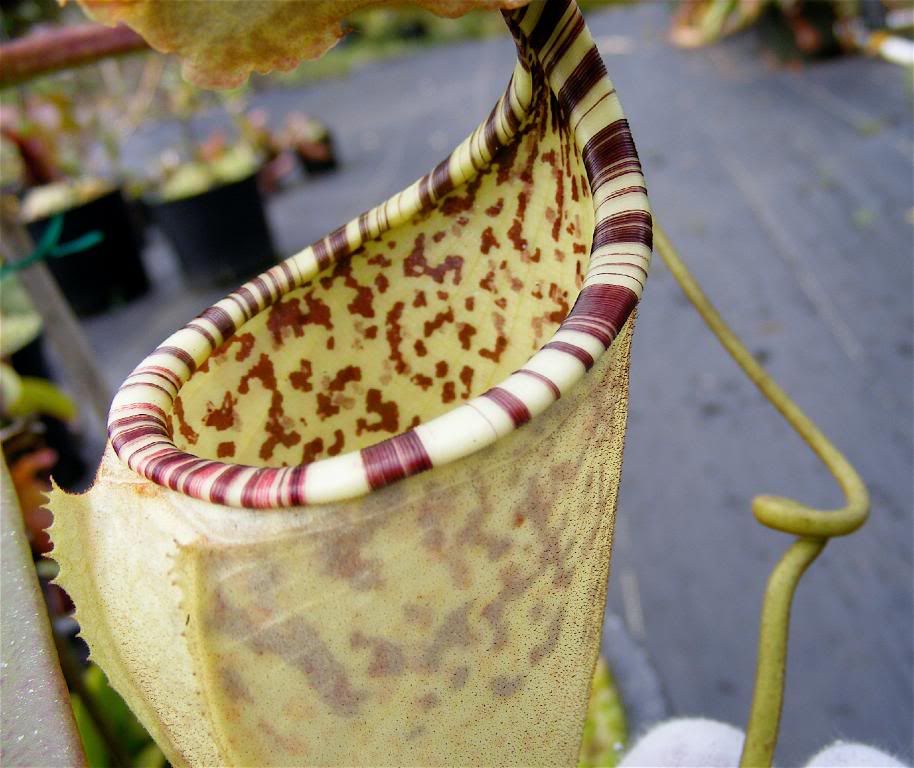 The coloration is definitely different but coloration is anything but definitive here. This might be explained by a number of factors: environmental, maturity or simply natural variation. A single plant is not a species. Species are populations and populations have their ranges of variability. Botanical descriptions ignore, for the most part, those variable factors and are based upon only those characteristics considered common and consistent. Some factors are more important than others but no one factor is sufficient to a definitive definition. Things like 'eye spots' in a N. reinwartdiana or coloration in N. burbidgeae are considered, to one degree or another, definitional of N. reinwardtiana and N. burbidgeaa but the absence of 'eye spots' or less dramatic coloration in a particular pitcher is not sufficient to exclude a plant from the species. I was hoping Geoff would return to this discussion and comment further on the pictures of the leaves, etc. but we may have make this whole thread a bit embarrassing now. If, I had to have only one authority here, it would be Geoff. Just the suggestion that "it does not look right" from him is enough to plant, in my mind, the seeds of doubt. The plant itself will reveal itself in the future and, should it show us something definitive, I will post it. |
|
|
|
Post by rsivertsen on Feb 12, 2009 12:28:41 GMT -10
I would attribute these minor differences to basic genetic diversity within the gene pool, especially if these plants originated from separate, isolated and different populations, as all other factors regarding the plant's leaves, stems, and flowers are also fairly consistent. - Rich
|
|
Dave Evans
Nobiles
   dpevans_at_rci.rutgers.edu
dpevans_at_rci.rutgers.edu
Posts: 490
|
Post by Dave Evans on Feb 12, 2009 18:34:03 GMT -10
The last time Exotica told us we were mistaken, we didn't disagree with them and deny it (like you), we accepted the information. We asked questions and then began to see the truth. There's a huge difference between Exotica's opinion and Dave Evans' opinion. If you want to pretend they're equal, that's your loss. If that is just plain old N. burbidgeae, Exotica wouldn't have said anything. For them to make a post, with photos, and reply, don't you think they must have noticed features you don't see? Err, Michelle... I do agree the one photograph does show an odd looking pitcher. However, I can't extrapolate this "odd pitcher" into a plant that must be a hybrid. *Could/might be a hybrid* seems a lot more accurate. Could just be a odd pitcher too. Even my N. burbidgeae show a fair amount of differences, in fact not a single pitcher produced by any of my four clones has been a repeat. Sometimes the peristomes are wide, sometimes thin. The shapes of other parts of the pitchers vary a lot too, sometimes tall and thin sometimes stout and wide--the "classic shape" for N. burbidgeae. If you look at more photos, you'll see this species does in fact display a fair amount of pitcher shape variation especially the intermediate pitchers. One plant has red leaves. Does it also have to be a hybrid? I mean, it could be a hybrid, but does it *have* to be a hybrid? |
|
|
|
Post by ep on Feb 13, 2009 21:05:57 GMT -10
Hi All, Thank you Michelle and Sam for your kind words. Embarassed? No, only if I made a mistake or get caught with my pants down  The only thing I would ask is that members who make comment in these discussions, please give some backup to their input. Either with photos or experiences or references, as it helps with resolutions. Dave Evans, for example, you have made many statements in this and other forums and when I have asked you to post photos, they are not forthcoming. Are you just speculating? If so, please say that, as more inexperienced members tend to believe those posts. Regarding the topic at hand, I have given it some more thought after reading all the input. The reason we said anything is because the pitchers just didn't look right. Sometimes it is hard to put a finger on what seems out of place exactly. At first I thought it was just the shape of the pitcher, mouth angle, pitcher colour, over undulation of the lid etc. but then I found that old photo of the intermediate of our plant, which was similar in shape although Sam's was an upper. I also know that pitchers can vary due to incorrect cultivation techniques. However Sam is a great grower and I don't think that this is the case. So it seemed that the biggest thing against this plant being a pure species was the colour. An alternative name for N.burbidgeae is 'Painted Pitcher Plant' , named because of it's external markings. My experience in the wild with this plant is nil, however, Clarke, Kurata and Jebb and Cheek all make reference to the colour being a definitive characteristic from all other species. I have seen a few of these all white N.burbidgeaes, other than Sam's, yet there has never been any reference to them in the wild, where populations are supposed to be limited. Sam, I also looked at the additional photos you posted. I can see how you could get this plant to fit the descriptions. It is very close but it still didn't seem right to us. It does not seem like a primary hybrid with anything that grows with it. Can you tell me, is this plant the same age as your others but the fastest growing? Was the origin of these plants from wild collected seed either tced or sown normally? I know at first it looked like it was showing N.fusca characteristics and I thought about the point Sam made about it lacking coulour if N.fusca was involved. However, we have a plant which we have had for many years which we were told was a white N.fusca. It is similar to the plant BE calls their orange N.fusca. It does look a bit like N.fusca but on closer examination N.burbidgeae traits can be seen in it. If you like to re-read any descriptions, you can see that the description for N.burbidgeae and N.fusca are very close in the plant characteristics. Yet one would expect that the hybrid with these two species, even a complex one with the female being N.burbidgeae, would have some external markings. Therefore what could it be? After much deliberation and thought and examination of the plant parts Sam posted, I would not be surprised if the hybrid culprit is N.stenophylla. I know that there has been no mention of this in texts I have read but they do grow near each other. It also accounts for the plant parts that don't seem to fit. So for what it's worth, that is our opinion. Wow, I think I hear the monograph/texts pages rattling from here ;D Cheers, Geoff |
|
Dave Evans
Nobiles
   dpevans_at_rci.rutgers.edu
dpevans_at_rci.rutgers.edu
Posts: 490
|
Post by Dave Evans on Feb 13, 2009 23:01:44 GMT -10
Hello Geoff,
Guessing? Maybe, but I do know a lot about Nepenthes... Anyway, as compared to pure N. burbidgeae, I think the addition of N. fusca would "condense" the height of the plant since N. fusca is pretty short.
The coloration does seem off though... The lid shape seems to match my plants lids and also the description in Jebb and Cheek; with the lid described as cordate with the apex rounded. Besides for hybridization, horticulture also let us find mutant plants and conserve them, when they would probably be lost in the wild due to competition. Simply gathering seeds and germinating them--you don't really know what might come up--is a great way to find new varieties.
|
|
|
|
Post by unclemasa on Feb 13, 2009 23:56:13 GMT -10
Thanks Geoff. I'll be keeping an eye on this plant and should it show us something more I'll update this thread. After a few hours with these taxonomists my tax consultant is beginning to seem like an interesting, dynamic and really cool guy.  |
|
|
|
Post by witzelsucht on Feb 14, 2009 6:34:11 GMT -10
|
|